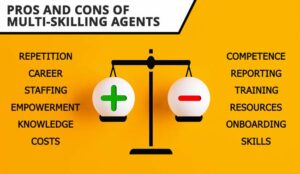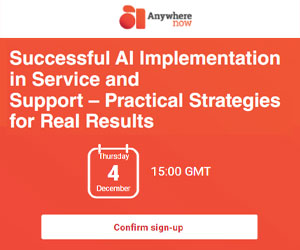Multi-skilling has been a hot topic in the contact centre for the last twenty years. In recent times, it has become more widespread and also vastly more complex.
James Barnes examines the benefits and pitfalls of multi-skilling in the contact centre.
How multi-skilling works
The general process can be explained using the following example.
Let us suppose that I manage and operate a Pet Insurance Contact Centre, taking calls from the owners of dogs, cats, rabbits and so on.
Scenario 1 (non-optimised)
A dog owner calls in to Pet Insurance Contact Centre, and the following two agents are free to handle the call:
- Janet, who is skilled in the insurance processes for both cats and dogs, and is the longest-waiting of the two available agents. (C&D)
- John, who is experienced only in the insurance processes for dogs.(D)
As longest waiting, Janet receives the call. A call from a cat owner then joins the queue, and unfortunately only the skilled canine-oriented John is available. The cat call, having held for some minutes, abandons, and this results in a missed service level, an unhappy customer and, of course, an unhappy cat.
Scenario 2 (optimised)
A dog owner calls in, and this time the following two agents are free to handle the call:
- Janet, who is skilled at Level 2 in both cat and dog insurance procedures, and is the longest-waiting available agent. (C2&D2)
- John, who is experienced only at Level 1, and only trained in the insurance processes for dogs. (D1)
As the top dog-skilled agent, John is selected by the optimisation process to receive the call, using as its selection criteria the skills matrix outlined below. A cat call then queues and, as multi-skilled optimisation has kept Janet available for just this eventuality, the cat insurance service level is now met. Happy customer; happy contact centre; happy cat.
Skills matrixes can be easily created to maximise the optimisation of multi-skills. Generally the greater number of skills an agent has, the lower down they go on the queue.
In an example like the above, a skills matrix would look something like this:
| Single Skilled | D1 |
| Two Skills | D2 & C2 |
| Three Skills | D3, C3 & R3 |
Of course, to fully understand the implications of multi-skilling, it is important to create a table of every single skills combination at your disposal, and to keep a record of the number of agents in each combination. Any imbalance can be tweaked easily enough through amendments to the skill prioritisation or script queuing rules, or by utilising a workforce management system with simulation software.
To understand the process, it can help to visualise a baseball pitcher (representing the queue), whose job it is to make sure the appropriate catchers (agents) are available to catch any given call at just the right moment.
Inbound Voice – two core forms of multi-skilling technology
Even in this modern world of social media, Inbound Voice plays a foundational role in multi-skilling. There are two key types:
- Groups – This is generally found in PBX environments where multi-skilling is formatted by group. Assigning an agent to a specific group will determine the type of calls that the agent receives. In this limited environment, more specific rules cannot be set, limiting the scale of multi-skill transformation.
- Skills – Most modern ACD and delivery systems offer multi-skilling at an individual level, enabling the assignment of different query types to specific agents, in accordance with their individual priority level. Though more complex to manage, this is a major advantage over Group assignment technology.
Rules in the skill environment are defined by two core levels:
- Queue/Cloud – This works by differentiating call types and allowing for the implementation of many scripting rules, which can help to prioritise calls (usually revenue over service) and deliver the caller to the most appropriate agent. Opportunities for enhancing multi-skilling rules using Cloud are quite often missed, and the likelihood is that there is much unused power sitting idle in your server room.
- Agent Skills – As well as the number of agent skills, most modern ACDs offer priority settings (not Cloud priority settings) which can empower you to decide, when presented with a number of available advisors, who should receive the contact. This is a great and powerful tool, but it is not without its pitfalls. These will be discussed shortly.
What are the benefits of multi-skilling?
- Resource Saving – In a single voice queue, staffing calculations such as Erlang ensure that, depending on the volume of contact, average handling time and service level, there is sufficient free available time to cope with the spikes and still meet your SLAs.
- Calculating multiple single queues as one or fewer queues reduces the calculated available time and overall resource required. Of course, your saving will depend upon the number of multi-skilled advisors in your workforce. Top-of-the-range workforce management systems will further calculate multi-skill efficiency and, through a schedule-generation simulation process, will align your multi-skilled agents into the most efficient time frames.
- Resource Optimisation – As well as potential resource savings, there are tantalising potential gains in optimisation, especially for small contact centres which are open to dramatic transformation.
- Staff Development – Offering a structured development and training programme can help retain agents for the long term. Using a formal structure, your agents can gradually become “upgraded” with new skills, improving their self-esteem and reducing the monotonous nature of their working days.
Drawbacks of multi-skilling
- Increased AHT – Although your agents may find it tedious to handle hundreds or even thousands of the same type of query, single-skilled agents soon develop an expert knowledge of the processes for that type of query, reducing AHT. A more varied selection of queries requires more knowledge, naturally increasing the call time. In this way, multi-skilling can become cost-inefficient.
- Unfair Distribution Of Work – Where agents are tasked with dealing with different types of queries set with different skills priorities, inter-team resentment can be caused because of the perceived unfair distribution of work. Constant validation and rule-tweaking is required to maintain an equal distribution of work and, by proxy, a happy contact centre.
Pitfalls and common mistakes
- “The Ever Sinking Queue” – Great care needs to be taken with queue priority levels set in multi-skilled environments. Where there are constant queues, the higher priority calls will be connected (queue jumping) before those of lower priority, meaning that, in a constant queue scenario, the lower priority call will never actually reach an agent. This can be resolved through intelligent scripting, or the implementation of an “If” statement, which will only allow for the utilisation of multi-skilled agents if a certain criteria (such as agent availability in another skill) has already been met.
- “Queuing reality”: Multi-Skill Agents Become Single-Skill Agents – If a contact centre has different priority sets related to agent skills (for example, top skilled for horses in a Pet Insurance Contact Centre), the formation of a constant horse queue can effectively cause all agents to become single-skilled, since the horse calls would take connection precedence over dog, cat and rabbit calls. Great care must therefore be taken when setting priority-level agents.
Summary
Multi-skilling can be a powerful and empowering tool, and bring about benefits from resource savings to potential decreases in attrition. But whether you define your multi-skill rules at agent or queue level, hopefully both, great care must be invested in order to avoid the potential pitfalls. Done the right way, though, the implementation of multi-skilling can transform your contact centre. So, kick off a review today – it might just be the key to unlocking your success.
James Barnes is an independent consultant working for Customer Contact Consulting
Author: Jo Robinson
Published On: 25th Apr 2012 - Last modified: 15th Aug 2025
Read more about - Customer Service Strategy, Call Routing, Customer Experience (CX), Service Strategy










































